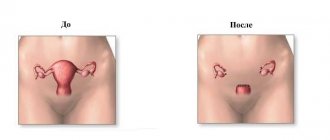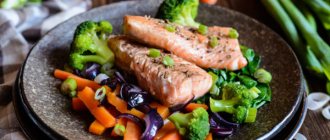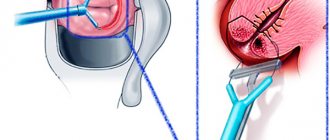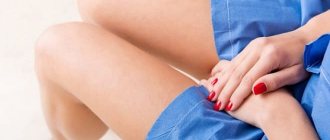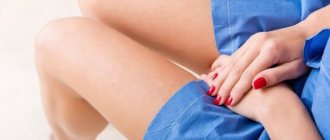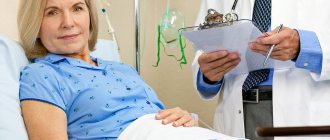Postoperative diets
20.09.2016
Uterine fibroids are a benign tumor that, for various reasons, develops from the muscle tissue of the uterus. More often, such formations are found in women over 35 years of age, although recently doctors are increasingly discovering fibroids in younger women. The disease is most often asymptomatic and is treated mainly with conservative methods. However, if the tumor is large, is growing rapidly, is located on the inner surface of the uterus, as well as if there is obvious pain and signs of necrosis of the fibroid node, surgical removal of the fibroid is recommended. Rehabilitation after such an operation involves, among other things, special nutrition.
- What foods should you avoid?
- General rules
- Meat dishes
- Cellulose
- Vegetables
- Vitamins
After surgery to remove uterine fibroids, the patient, as after all abdominal operations, will be recommended a special diet.
All nutrition during rehabilitation should be based on the fact that many patients develop protein deficiency, vitamin deficiency and dehydration. A diet for uterine fibroids should help correct metabolic disorders, as well as provide to the greatest extent all the body’s needs, not only in calories, but also in nutrients. In addition, in the postoperative period, it is necessary to take special care of strengthening the body’s defenses, stimulating the healing of the postoperative wound and maximally sparing the affected organs.
Description of the method
The modern laparoscopic method is used for research and surgical interventions on both the abdominal organs and the female reproductive system, as well as in the field of thoracic surgery, which involves diagnosis and surgery on organs located in the chest. The most commonly used options for laparoscopic operations are:
- Cholecystectomy, which is a laparoscopy of the gallbladder. The price of the operation depends on the clinic and accompanying diagnoses.
- Gastrectomy accompanied by gastric resection.
- Manipulation of the ureter and bladder.
- Will's operation and pancreaticoduodenectomy - excision of a fragment of the pancreas or duodenum.
- Appendectomy or removal of appendicitis. Diet after appendicitis surgery will be discussed below.
- Pulmonary laparoscopy.
- Resection of a section of the large or small intestine.
- In the field of gynecological medical practice, surgery is performed to remove cysts in a woman’s ovaries, as well as to eliminate pathologies of the uterus and fallopian tubes. Diet after laparoscopy is important.
Examination before surgery
Any surgical intervention is performed after receiving the results of a detailed examination of the patient, which, as a rule, includes:
- Clinical and biochemical blood tests in laboratory conditions.
- Hardware diagnostics, involving ultrasound and X-ray examinations, as well as computed tomography and magnetic resonance imaging.
The postoperative period after laparoscopy requires compliance with certain rules, for the most part they relate to nutrition and physical activity. If you strictly follow all the specialist’s recommendations, the recovery period will not take much time and will lead to a complete recovery.
Why do you need a diet after laparoscopy?
The feasibility of therapeutic nutrition after surgery
The very first thing to remember when choosing nutrition after surgery is the optimal combination of carbohydrates, fats and proteins, that is, beneficial substances in the diet. The correct ratio of these substances allows the gastrointestinal tract to function normally. In this way, it is possible to prevent various dyspeptic manifestations, as well as avoid pain and difficulty in digesting food and flatulence. Bowel movements will also not cause difficulties such as constipation or diarrhea, as long as the correct balance of nutrients is maintained.
The diet after laparoscopy involves eating exclusively healthy foods. Nutrition is aimed at strengthening the patient’s immune system, which has been weakened due to pathology and the intervention performed. With proper nutrition, the recovery process occurs at an accelerated rate. The sutures are tightened faster, while the likelihood of postoperative complications is reduced to a minimum. In addition, a balanced diet helps remove toxins from the body that accumulate under the influence of anesthesia, which significantly facilitates the functioning of the liver.
A diet after appendicitis surgery will help you quickly get back on your feet. It also helps restore normal functioning of the reproductive and hormonal systems. This also applies to gynecological laparoscopy. If you can’t create a menu yourself, you can contact your doctor or nutritionist.
So, what should be included in the diet after laparoscopy?
Other methods of fibroid removal
There is not always a need to use radical measures to remove the tumor process. There are indications for using more gentle techniques to eliminate the problem.
Laser
The risks when performing laser manipulation are minimal, safety is at a high level. The effect of the laser is dosed and differs in directionality.
During the operation, unhealthy tissue will be affected, but the layer without pathology will be intact.
After this procedure, no scars or scars were noted in the patients. There will be almost no bleeding, because there is no mechanical effect on the body.
Probably, when using this type of treatment, the rehabilitation period will last the shortest.
Doctors often suggest removing restrictions from the patient 3 days after surgery. Laser therapy is highly effective, which is why many women want to remove myomatous nodes using it.
Embolization
UAE is also very popular among patients, but is distinguished by its high cost.
If we compare a radical measure to remove fibroids, then when used, the disease can return in 40% of cases. The effectiveness of embolization is much higher, because doctors detect new lesions in only 2% of patients.
After local anesthesia, a catheter is inserted into the patient through the main artery of the thigh.
A special solution flows through it, allowing you to clog the vessels and stop the nutrition of the myomatous nodes. Subsequently, they shrink and die.
There is a certain unpleasant nuance: after a medical procedure has been performed, the patient may feel a painful sensation in the lower abdomen. The spasms can bother her for several hours and are not always relieved by medications.
Unfortunately, there is little information about the manifestations of the consequences and effectiveness of this treatment. Since there have been no studies conducted in the field of studying reproductive function after UAE. But now we can say with confidence that 5% of women complain about the absence of menstruation. As a result of the manipulation, amenorrhea developed, which cannot be overcome.
FUS ablation
A complex technique that is a conservative type of therapy against uterine fibroids.
When controlled by a magnetic resonance imaging scanner, the patient's formations are evaporated using ultrasound. In this case, the fabric and its layers will remain undisturbed.
By heating to 90 degrees, the liquid from the capsule is completely evaporated. Then the myomatous node itself disintegrates. In this case, the patient does not experience severe pain during the removal of the pathology
Unfortunately, no precise study of the technique has been carried out, so its use is rare. Moreover, there are limitations; the use of ultrasound therapy is indicated if the fibroid is localized on the uterine fundus or in the area of the anterior wall. Also, the tumor volume should not exceed 9 cm, otherwise there is a risk of complications.
Women who suffer from infertility or have not previously given birth to children will have to refuse treatment with this method. Also, subserous formations growing on a stalk cannot be removed with ultrasound.
Features of postoperative nutrition
After surgery, it is important to pay special attention to the chemical composition and properties of a particular product. In addition, the method of preparing the dish and the interval between meals is key.
A number of dietary features should be taken into account after surgery:
- The first meal immediately after surgery requires consultation with your doctor. If there is no nausea, you can eat chicken broth six hours after anesthesia.
- The temperature of the food should not be high; it is necessary to maintain comfortable values. The aggressive effects of hot foods on the digestive system must be avoided.
- An interval of 2.5 hours must be observed between meals. In this case, the serving size should not exceed 300 grams. It is important to avoid overeating.
- You should give preference to products whose composition is enriched with vitamins and minerals, and also maintain a balance of nutrients.
- It is recommended to use herbal infusions instead of tea.
- Fried foods should be completely excluded from the diet. Products can be stewed, boiled and baked without adding oil.
- In the first days after surgery, it is necessary to eat foods that have been ground in a blender, as this will reduce the likelihood of developing dyspepsia.
- You can't change your diet suddenly. New products are introduced gradually, starting from light ones and moving on to difficult-to-digest ones.
- When introducing fruit, it is necessary to peel off the tough skin.
You should not stop following a therapeutic diet after discharge from the hospital. The risk of postoperative complications persists for one month, so during this period you should follow a diet. Alcohol is completely excluded from the diet for the entire rehabilitation period.
What does the diet suggest after removal of the gallbladder by laparoscopy?
Rehabilitation
In most cases, the rehabilitation period takes no more than 4 weeks. If a major surgical intervention was performed (abdominal surgery), it will take two months.
To quickly heal the wound, experts recommend abstaining from sexual intercourse for a couple of months and following a strict diet, which will prevent digestive tract disorders or constipation.
Your daily lifestyle should include walks in the fresh air, gymnastics or dancing, and swimming.
Consultation on rehabilitation measures can be obtained from your attending physician. If all recommendations are followed, it is possible to achieve complete recovery in the shortest possible period of time.
After organ-saving intervention, pregnancy cannot be ruled out. However, doctors do not advise patients to give birth naturally to prevent suture rupture. Women in labor undergo a caesarean section.
Prohibited Products
On average, the duration of the diet is four weeks. In the future, you should consult a doctor, and also focus on your own well-being. The following foods should be excluded from the diet:
- Animal fats including lard, butter and lard.
- Smoked meat and fish products.
- Fatty mayonnaise-based sauces, as well as ketchups.
- Canned foods, including vegetables, fish and meat.
- Pickled and salted vegetables and mushrooms.
- Pastries and breads based on whole grain flour.
- Sweet products and sweet desserts.
- Legumes including chickpeas, peas, lentils and beans.
- Raw vegetables.
- Firm fruits like pears and apples, as well as citrus fruits.
- Carbonated drinks and kvass.
- Fast food.
- Nuts.
- Spices and various seasonings.
Also, restrictions are imposed on sausage products, milk and fatty varieties of cottage cheese, and dried fruits. Violation of the correct diet can have unpredictable consequences in the form of postoperative complications. In a patient with a diet failure after removal of the gallbladder by laparoscopy, the sutures may come apart due to difficulty in defecation.
Authorized Products
The choice of food products for a therapeutic diet after laparoscopy should be focused on the ease of digestion of food, as well as the content of minerals and vitamins. The following foods are recommended after surgery:
- Porridge cooked in water or low-fat milk. The consistency of the porridge should be liquid.
- Vegetables prepared by steaming, stewing or boiling. Vegetables such as beets, carrots, zucchini, liquid mashed potatoes, light vegetable soups and broths are allowed.
- Low-fat fish such as haddock, pollock, steamed hake.
- Boiled poultry (chicken or turkey), steamed cutlets.
- Stewed beef liver.
- Soft pasty cottage cheese, yogurt, kefir and fermented baked milk. The fat content of fermented milk products should not exceed 2.5%.
- Jelly made from fruit or oatmeal.
- Seafood.
- Peeled fruits and berries.
- Steam omelette or microwave.
- Compotes.
- Freshly squeezed juices, diluted with water.
The amount of salt should also be limited, so salting the listed dishes is not recommended.
The price of laparoscopy of the gallbladder in Moscow varies between 30 thousand rubles. Of course, it is better to go to the capital and get qualified treatment, but in St. Petersburg there are also decent offers from private clinics starting from 10 thousand rubles.
Recommended Recipes
What can you cook during the recovery period, what dishes? Nutritionists offer a varied and healthy menu of familiar products.
Vegetable soufflé
Finely grate the beets or carrots and simmer in a small amount of water. When it becomes soft, add the whipped egg white with salt and place in the oven for 18-20 minutes. This is a safe and healthy dish in the first postoperative days.
Chicken soufflé
Pre-boiled potatoes (2 medium potatoes) and chicken fillet must be chopped in a blender. To the mixture you need to add a slice of white bread softened in milk, one yolk and whipped whites with salt. Then you need to grease the baking dishes with vegetable oil and lay out the finished mixture. The soufflé is baked in the oven for about 20-22 minutes at 182 degrees.
Fish soufflé
To prepare a delicious soufflé, you need to take marine varieties of fish - hake, pike perch. Boil fish (200 g) together with carrots (1 piece) and grind in a blender. Add raw yolk and 2-3 tbsp low-fat sour cream to the resulting mixture. Beat the egg white into a foam with salt and add to the mixture. The mass is poured into molds and baked in the oven for about 22-25 minutes. Temperature 180 degrees.
Curd soufflé
To prepare this dish you will need nut mass and finely chopped apricots. Peeled nuts can be minced in a meat grinder or crushed in a nut mill. The mass is mixed with finely chopped apricots and curd mass. The mixture is filled into molds and baked in the oven. The mold is pre-greased with vegetable oil.
For 100 grams of curd mass, take 30 grams of apricots and nuts, half an egg, a spoonful of semolina and a little sour cream. Sugar is added to taste.
Meat soufflé
Boil the lean meat and blend twice in a blender until pureed. The puree is mixed with cooled semolina porridge and raw yolk is added. Beat the egg white with salt and add to the puree. The finished mass is laid out in molds and steamed.
Milk soup-soufflé
Dilute the milk with water and boil a couple of potatoes, carrots and onions. If desired, you can add some rice grains. When everything is ready, cool and blend in a blender. You can eat it with chopped herbs - dill, parsley.
Note! You can’t put fried vegetables in the soup - you need to boil everything in water.
Diet puree soup
To prepare a healthy and safe soup, you need to boil and grate carrots (1 piece) and potatoes (2 pieces). Boiled rice is whipped in a blender and added to the pureed vegetables. The mixture is diluted with boiling milk (cup) and served with a small piece of butter. The soup can be eaten with white bread croutons.
Stuffed beets
For this dish you will need one squash, one apple, a small handful of raisins, sour cream and cinnamon. Boil the beets, remove the middle part with a spoon and fill with rice mixture. To prepare the rice mass, you need to boil the rice, mix it with finely chopped apple and raisins, add a small piece of butter and sprinkle with cinnamon sugar. When you place the rice mixture into the beets, pour a spoonful of sour cream on top. Place the stuffed beets in the oven and bake.
Fish quenelles
This dish is made from pike perch. Mix the minced fish with the soaked bread and milk/cream, whisking well with your hands. Using a tablespoon, place the quenelles into a frying pan, sprinkling it with vegetable oil. Then pour in cold water and boil for about five or six minutes. The dish is ready.
Steamed meatballs
Prepare meat puree from lean meat (150 g), grind it well and beat in a blender. Combine meat puree with viscous rice porridge (half a glass). Beat the mixture again in a blender and add 1/6 of a raw egg and a spoonful of butter. Shape the meatballs and place them in a frying pan moistened with vegetable oil, then pour in water. Boil the meatballs in water for about 5-6 minutes and serve.
Steam omelette
To steam an omelet, you need to mix 2 eggs with a quarter cup of milk and pour into a mold moistened with vegetable oil. Cook the omelette in a water bath or steam.
Puree porridge
How to cook pureed porridge? To do this, grind the cereal in a coffee grinder and make flour from it. Pour flour into boiling milk or water in a thin stream, stirring quickly. In a minute the porridge is ready. Add salt/sugar as desired.
Other features of the therapeutic diet
After laparoscopic surgery, especially in the case of removal of appendicitis, as well as treatment of the gallbladder, it is necessary to pay special attention to nutrition, since these organs are part of the digestive system. Nutrition has its own characteristics depending on the number of days that have passed after surgery:
- Days after surgery. During this period, the person comes out of the state of anesthesia. You should not eat for 24 hours after surgery; only non-carbonated water is allowed. If there is no nausea or vomiting, you can drink the broth six hours later.
- On the second day you can start eating. To begin with, the best option is low-fat yogurt, including drinking yogurt. The broth can be supplemented with noodles.
- Over the next 2-3 days, you can introduce liquid mashed boiled potatoes, boiled fish or chopped chicken with broth, as well as porridge, pasty cottage cheese and pureed fruit.
- After 4-5 days, you can add steamed or stewed vegetables, a small amount of marshmallows, and baked apples.
Your doctor will help you plan a diet after appendicitis removal by laparoscopy week by week. At the end of the first week after surgery, the patient can begin to eat fully, giving preference to the permitted foods listed above. To normalize the bowel movement process, you can add boiled beets and chopped prunes to your daily diet. You can mix the resulting mixture with natural low-fat yogurt.
Contraindications
Laparoscopic surgery is contraindicated under the following circumstances:
- The patient has diseases in which surgical intervention can create a real threat to her life (pathology of the heart and blood vessels, decompensated respiratory failure, liver failure, bleeding disorders, diabetes mellitus);
- Oncological pathology of the genital area cannot be excluded;
- The size of myomatous nodes after hormonal treatment at the stage of preoperative preparation remains more than 10 cm and there is no tendency to reduce them. We discussed the main nuances of hormonal therapy for uterine fibroids in another article;
- It is known that removal of multiple nodes will not restore the reproductive function of the uterus and the desired pregnancy will not occur;
- Acute inflammatory processes in the abdominal cavity, acute respiratory viral infections or exacerbation of chronic diseases;
- Period of menstruation;
- Uterine pregnancy (if there are no strict indications for surgical treatment);
- The patient is severely malnourished;
- There are hernias in the abdominal area.
Obesity and severe adhesions in the abdominal cavity can also serve as a limitation to surgery.
With progressive adhesive disease, there is a limitation on laparoscopic myomectomy. The picture shows the degrees of the adhesive process: I - limited to the area of the postoperative scar; II - localized in combination with single spikes in other places; III - adhesions occupy 1/3 of the abdominal cavity; IV - occupy most of the abdominal cavity.
It is believed that laparoscopic myomectomy is most effective when there are no more than 4 myomatous nodes on the uterus and when the size of the organ is up to 12 weeks. In all other cases, preference should be given to laparotomy access. At the same time, it should be noted that with the advent of high-tech morcellators in practice, it became possible to perform laparoscopic operations for fibroids up to 15-16 weeks in size. A useful table of fibroid sizes in weeks and mm can be found in our article.
In addition, with multiple nodes, there is a high probability of disease recurrence (more than 30%), while with single formations, relapse occurs only in 10-20% of cases.
Features of the rehabilitation period
It is important to follow a diet after surgery without fail.
Restrictions after laparoscopy apply not only to nutrition, but also to various types of stress on the body, including physical ones. For the first two weeks, doctors recommend completely avoiding sports. Lifting heavy objects during this period is also unacceptable, as it can lead to divergence of the seams. However, complete cessation of physical activity is not recommended. The best option is measured therapeutic walking. This will help avoid the appearance of adhesions. The distance and speed of movement is selected by the patient depending on his general well-being.
Surgical intervention using the laparoscopic method extremely rarely provokes complications. The rehabilitation period takes much less time than in the case of traditional surgery. Other advantages of laparoscopy are:
- Low probability of injury to organs adjacent to the operated area.
- Reduced risk of developing an infectious lesion of the body. It is more difficult for pathogens to penetrate through small incisions.
- The likelihood of adhesions occurring is also minimal.
- No aesthetic postoperative problems.
Proper nutrition speeds up the process of recovery of the body after surgery, so you should not be negligent in taking the advice of a specialist on this issue.
Contraindications to laparoscopy
Despite the huge number of available advantages, there are some conditions of the body when this method is contraindicated. They must be taken into account when deciding on the advisability of removing fibroids and determining the possibilities of using one or another method.
Laparoscopy is not performed in the following cases:
- the presence of pathological disorders in the condition of the lungs, heart or vascular changes,
- suffered a heart attack or stroke,
- blood clotting disorders,
- in the presence of a hernia,
- deviations in the patient’s weight in one direction or another,
- myomatous nodes are too large,
- pathologies in the condition of the kidneys or liver,
- oncological processes developing in one of the pelvic organs.
In this case, you have to use other surgical methods, which may be more traumatic, but nevertheless quite effective. Which one is preferred is determined by the doctor based on the examination and existing indications.
Diet after laparoscopy of appendicitis in adults
Resection of the appendix involves damage to the integrity of the intestinal walls, so special attention in the postoperative period should be paid to maintaining a proper diet. It is strictly not recommended to load the stomach and intestines during this period. Moreover, if peritonitis develops against the background of appendicitis, then the attitude to nutrition should be much more strict. On the recommendation of a doctor, it is allowed to introduce herbal teas based on medicinal herbs, namely chamomile, into the diet.
If no emergency situations arose during the operation to remove appendicitis, and it proceeded as usual, then nutrition should be started a day after the operation. In an inpatient setting, the patient remains under the supervision of a surgeon for one week. The specialist will describe the diet in every detail. An important point in nutrition after removal of appendicitis is to thoroughly chew food or grind food in a blender.
Dishes for therapeutic nutrition should be fresh, without adding salt or seasonings. Therefore, the first week of rehabilitation is the most difficult and strict in terms of nutrition. It is allowed to return to the general table only one month after the operation.
Indications for surgical treatment of uterine fibroids
If the tumor is small in size, not prone to growth and does not cause discomfort to the patient, treatment is carried out with the help of medications. However, if fibroids have specific factors, then surgical treatment is recommended.
Surgery to remove fibroids is indicated in the following cases:
- the tumor has reached a large size - similar to the fact that a woman is 12 weeks pregnant or more;
- necrosis of the tumor, which can be caused by twisting of the pedicle or other malnutrition of the tumor;
- the appearance of a pronounced pain syndrome that cannot be relieved with medications;
- serious functional disturbances in the activity of organs located near the uterus;
- high probability of malignancy of the fibroid node;
- there are concomitant pathological processes, in particular endometriosis or ovarian cancer;
- heavy bleeding accompanying diseases that cannot be eliminated or occur too often, resulting in severe anemia;
- growth of myomatous neoplasm at an intensive rate;
- difficulties conceiving or bearing a child.
If the fibroids are gigantic in size, developmental or localized, the uterus undergoes radical removal.
Depending on the volume, fibroids are classified into:
- small – the tumor reaches no more than two centimeters, similar to the 5th week of pregnancy;
- average - from 2 to 6 cm, as at 10-11 weeks;
- large – 12-15 weeks and more than 6 centimeters, respectively;
- giant – enlargement of the uterus as in the sixteenth week of pregnancy or more.
Surgical intervention is performed in the presence of large and giant tumors. In other words, if the node exceeds the 12-week size, it is removed.
In some cases, smaller fibroids can be operated on, for example, when a necrotic process develops in a tumor formation or when there are difficulties with conception.
In children
You should also follow a diet after laparoscopy to remove appendicitis in children.
Parents should monitor the child’s nutrition during the recovery period. The diet is not much different from that prescribed to adult patients. Children need to eat often, but in small portions. Moreover, for the first day after removal of appendicitis, you should observe therapeutic fasting, drinking only purified water. Starting from the second day, the child’s diet is enriched with permitted foods. It is more difficult for a child to stick to a diet than for an adult, so parents need to pay a lot of attention to this issue.

